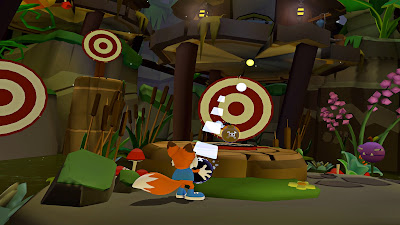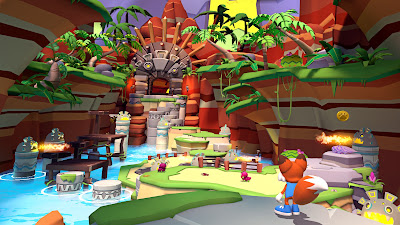Though I had played both versions of Super Lucky’s Tale before, I had not previously played the original Lucky’s Tale, as it was released for a VR platform (Oculus Rift) that I did not have. By chance when looking at the listing for Moss: Book II, I spotted a digital-only listing for the PlayStation VR version of Lucky’s Tale, which is a port of the Oculus Quest 2 remaster with updated graphics to match the sequel. Although I liked the game after finally getting to play it and thought it held up as a good example of third-person VR, one major issue made it nearly unplayable for me.
One day, an anthropomorphic fox named Lucky is playing with his friend Piggy, a non-anthropomorphic pig. While the two are asleep, the evil Glorp appears and takes Piggy away, intending to use him as a snack. Lucky goes after Glorp to rescue his friend, though fortunately Piggy leaves behind a trail of coins for him to follow.
While not that complex a story, especially when compared with Super Lucky’s Tale, the simple goal of rescuing Lucky’s friend isn’t necessarily bad and its short length also prevents it from going on too long, as is the case with most VR games.
Since I played Super Lucky’s Tale first, I will say that the core gameplay of Lucky’s Tale is largely similar to that of its sequel, with one main difference being that you don’t have the ability to burrow underground and collecting coins has no real purpose outside of giving you an extra life if you manage to grab 100 of them. On the subject of lives, losing all of them registers as a Defeat, and you must restart the level with five. Levels also end with a hot air balloon with a rope attached to it, granting you additional points based on how high you can jump onto the rope. Additionally, a way the game takes advantage of VR is that the trajectory of explosives is based on where you tilt your head to aim, plus if you do it right you can sneak attack some enemies from a distance.
 |
| The trajectory of explosives is determined by how you tilt your head. |
The game also has it fair share of unlockables, mainly statues the you can unlock by completing certain objectives, viewable in the Storybook, most of which require finishing the story and finding hidden presents in each level. Beating a level through Story Mode also unlocks two additional challenge modes for non-Boss levels, namely Time Trials and Red Coin challenges. Each of these require you to run through a slightly shortened version of the respective level without any checkpoints, with Time Trials requiring you to reach the end as fast as possible (with floating diamonds providing an ideal speedrun path) and Red Coins challenges requiring you to find all the red coins that are hidden in each segment of the level.
Like the core gameplay, the graphics and voice acting are also similar to that of the sequel, with Lucky’s character model being swapped out from the original to match. The framing of a storybook lends itself to an interesting presentation, something that the sequel would further expand upon, plus the stylized art direction gives it more of unique flair. While turning around at points during gameplay, I noticed some details that the developers didn’t really need to put in, such as huts placed behind you in a boss fight stage, however the fact that they did so anyway helps to flesh out the environment and increase the immersion for those who appreciate such details. In an interesting touch, Lucky’s respawn animations upon dying in water or lava even reflect how he died. While the voice acting is good, the game unfortunately lacks a subtitle option, meaning you need to listen very closely to the narrator’s voice to understand what they’re saying.
For those like me who get more easily freaked out over underwater simulations in VR, I will mention there is a single level in the game that takes place underwater, as well as a storybook page to match, though fortunately it doesn’t go any deeper than a coral reef. Additionally, the camera automatically follows Lucky to his position, which can cause motion sickness when standing up, something I could already feel coming on when I did so for two seconds, so sitting down while playing this one is highly recommended instead. Incidentally, this can also, at least initially, give the odd feeling that you’re riding some sort of theme park dark ride, with a close equivalent being the Haunted Mansion or Buzz Lightyear Astro Blasters rides at Disneyland.
 |
| Lucky's Tale has a stylized, immersive world. |
If there’s any one real complaint I have, it’s the calibration, or seeming lack thereof. Rather than calibrating automatically on startup like in other third-person VR games such as Moss or Ghost Giant, it calibrates base don your exact position while watching the (unskippable) intro cinematic, and the lack of a recalibration feature means you must watch the intro again just to get it to where you want. It gets a little bit of slack since it predates a number of modern third-person VR games, though the fact that this is a remaster makes the messy calibration a little questionable.
The original Lucky’s Tale stands up as a great example of third-person VR with enough updates to maintain visual continuity with its successor. The calibration system is a little more unintuitive than other VR games, but if you can get past that, you’ll have a great time, plus the $20 price point is a good match for the amount of content you get. Playing this is not necessary for understanding Super Lucky’s Tale, though I would still recommend playing this one anyway.


No comments:
Post a Comment